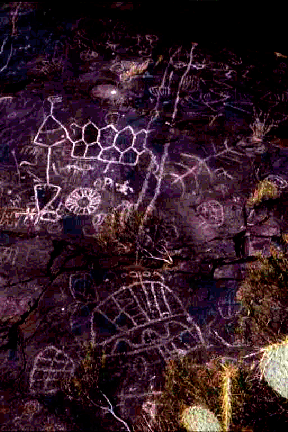|
This article first appeared in a 1997 2nd quarter edition of the SNRAE Newsletter and has been altered slightly to appear on the 'superhighway'.
 Several years ago at a cave in the southern reaches of the Spring Range, I noticed a stylized depiction of a bighorn sheep I had never seen before. The sheep was drawn in profile and simplified as to have only one horn and a single front and back leg. I refer to these bighorn sheep as BOSS (Bighorns of Singular Style). This spring, in another Spring Range canyon, I was struck by numerous representations of sheep portrayed in the same way. Since then, I've seen these cleverly simplified sheep in the north, south, east, and west parts of the Spring Range. Aside from the painted depiction of BOSS at that first limestone cave, all the other sites are petroglyphs found on quartzite. This quartzite consistently has a vertical plane and a second plane which ranges from horizontal to sixty degrees. It's on this second plane where most of the rock art is located at these sites.
Several years ago at a cave in the southern reaches of the Spring Range, I noticed a stylized depiction of a bighorn sheep I had never seen before. The sheep was drawn in profile and simplified as to have only one horn and a single front and back leg. I refer to these bighorn sheep as BOSS (Bighorns of Singular Style). This spring, in another Spring Range canyon, I was struck by numerous representations of sheep portrayed in the same way. Since then, I've seen these cleverly simplified sheep in the north, south, east, and west parts of the Spring Range. Aside from the painted depiction of BOSS at that first limestone cave, all the other sites are petroglyphs found on quartzite. This quartzite consistently has a vertical plane and a second plane which ranges from horizontal to sixty degrees. It's on this second plane where most of the rock art is located at these sites.
Since I wrote this first paragraph, I've been bumping into the BOSS quite a bit. SNRAE's Steve Stoney observed a depiction of the BOSS at a southern NV sandstone sight in a paper he presented to the American Rock Art Research Association. While browsing through my slides I noticed that the BOSS is at Forty Mile Canyon (a huge site SNRAE has visited twice on the Nevada Test Site featuring hundreds of elements, only two of which are bighorns-both of them BOSS. Curiously, the glyph on the top of that rock is a depiction of a sunray- and is used by SNRAE as a logo glyph).  At least a couple authors have mentioned that painted depictions of the boss from caves in the Mojave Desert and the Grand Canyon resemble bighorn split twig figurines. I was given a photo of the Little Black Mt. site in Arizona, by of all people my mother (who in all fairness is a strong and even adventurous hiker), which had the BOSS on it. At least a couple authors have mentioned that painted depictions of the boss from caves in the Mojave Desert and the Grand Canyon resemble bighorn split twig figurines. I was given a photo of the Little Black Mt. site in Arizona, by of all people my mother (who in all fairness is a strong and even adventurous hiker), which had the BOSS on it.
In the Spring Range, the BOSS is portrayed with a complex grouping of abstract and/or representational elements (the usual mysteries). The BOSS is depicted in a variety of ways (singularly, in groups, vertically, horizontally, seated, with exaggerated bodily dimensions- especially a large hind end, with a singular ear, with two heads - one facing each direction, and as a part of larger compositions). The BOSS appears to be in the middle epoch of glyph production- there's both older and newer glyphs at these sites. Stoney mentioned that there is a Hopi clan which uses as its unifying symbol a single horned sheep. These glyphs are more likely to have been made by Paiute-Shoshone people from the Ash Springs and Pahrump Valley areas who used this area at the time of contact. The true meaning of BOSS is a thing only its original creators may be privy to. Us glyph-heads may be left with only circumstantial evidence.
I know of no other place where the BOSS occurs so frequently and is such a major player. Several widely scattered pictograph sites in the west prominently display the BOSS and the BOSS does occur occasionally in its petroglyph form across the southwest. The sheer quantity of the BOSS in the Spring Range may indicate a BOSS tradition peculiar to the Spring Range. In your wanderings around the west, always keep your eyes on alert for the BOSS.
CONTENTS
NEXT
Send e-mail to c395smith@hotmail.com
|